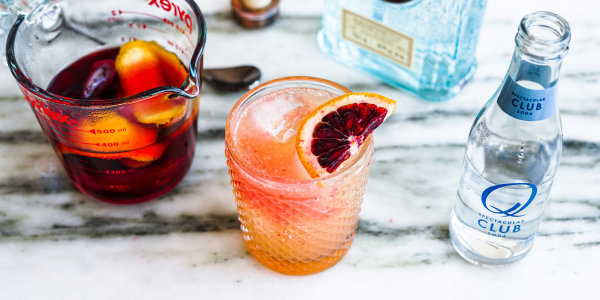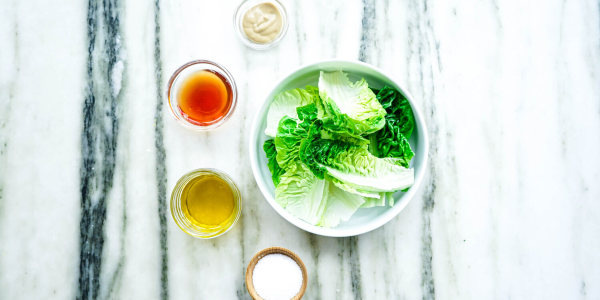Television personality Elena Besser is joining TODAY to answer cooking questions submitted by our viewers. She shares her hottest culinary tips to save over-seasoned sauces, add flavor to foods without using salt, spice up homemade simply syrup and build the best salad with perfectly balanced vinaigrette.
Is there a way to salvage a sauce that's too salty?
Yes! It is important to remember that all salts not are created equal, so if you have a recipe that calls for 1 teaspoon of salt, depending on the type of salt you use, your sauce can end up way too salty. As a rule of thumb, make sure that you always start with less of what a recipe calls for, because you can always add more, but once you add more, you can't take it out. When I think about the different flavors in cooking, I want to achieve balance. So, if something is too salty, I always try to fix it with the other flavors that can add balance, starting with acidity.
- Acid: Adding vinegar or lemon juice does a great job of balancing saltiness.
- Sweetness: You can also add a dash of honey or sugar. Opposites attract here and create balance.
- Fat: Another fix is adding some fat, a few pads or butter or a healthy glug of olive oil can absorb some of that saltiness.
- Dilute: If you are making a sauce that seems way too salty, dilute it with water, stock or more of the main ingredient. For example, if you are making a tomato sauce that is too salty, pop in another jar of tomatoes and then add in small amounts of the other ingredients, minus the salt, to fix it up.
Which spices are good alternative options for someone on a salt-free diet?
Unfortunately, it is really hard to replace things that aren't salt. But, while I always say "salt awakens flavor," there are definitely things you can do to up the flavor of the foods you are eating. I like to think about focusing on the other flavors you can enjoy such as sweet, heat, fat, acid and herbs.
- Sweet: Marinate your meats with fruit juices like orange juice; drizzle some honey or maple syrup onto your vegetables; add a little bit of sugar to a dry rub.
- Heat: Add in some hot peppers, hot sauce, chiles or hot spices to bring another dimension to the food you're eating.
- Fat: Olive, walnut and sesame oil are packed with powerful flavors that can elevate any meal.
- Acid: Vinegar, yogurt, citrus juice and citrus zest can add some serious dimension to anything you are cooking. When your veggies come out of the oven, squeeze some lemon juice on top and add some zest for a flavor boost. Marinate protein in yogurt to tenderize the meat and add even more flavor.
- Herbs and spices: Fresh or dried herbs can add tons of flavor. Bay leaves add great depth, while herbs like oregano, rosemary, and thyme add a cozy feel. I also love to use garlic and onion powder to add a rich and savory flavor to whatever I am cooking. Fresh onions and garlic are also a go-to flavor-booster, too.
Which flavors can be added to homemade simple syrup that will keep well in the fridge?
Homemade simple syrups are so much fun to make and easy as pie. All you need is an even ratio of 1:1 (1 part sugar and 1 part water). The sugar can either be white sugar or you can use honey or maple syrup. Combine them in a saucepan over a medium heat and cook, stirring continuously, until the sweetener dissolves.
When I make simple syrups, I like to think of them like a tea: Pick whichever flavors you like and add it into the mixture. The heat will cause the flavors to steep and infuse into the simple syrup. Once the simple syrup is made, make sure it cools completely before putting it in the fridge. Simple syrups can last in an airtight container in the fridge for up to a month.
- Tea: Add a couple tea bags of your choice, like Earl Grey, hibiscus or chai.
- Spices: Add warming spices like cinnamon, clove, allspice, nutmeg and ginger.
- Fresh herbs: Mint, thyme, rosemary and basil are fantastic choices. Place them in once the sugar dissolves and set aside at room temperature for 1 hour to continue to steep and strain out the herbs before adding to the airtight container.
- Citrus: Citrus zest does a great job of adding floral notes to simple syrup. Once the sugar has dissolved, just add the peels of citrus directly into the pot and steep for an hour before straining.
How do you make a simple vinaigrette and assemble a well-balanced salad?
Whenever I am making a salad dressing, I always play it SAFE. That's my little mnemonic device to remember all the things a dressing needs: seasoning, acid, fat and emulsifier. I do a 2:1 ratio (2 parts fat to 1 part acid) — for example, 2 tablespoons fat to 1 tablespoon acid or 1/4 cup fat to 2 tablespoons of acid.
Start by combining the acid and seasoning (salt) in a bowl or Mason jar. Add any emulsifier you would like and whisk to combine (rule of thumb, start with 1 teaspoon and you can always add more) then pour in your acid. Next, add in your fat: If you are making it in a bowl, whisk together as you drizzle in the oil. If you are making it in a Mason jar, add the oil, seal the lid and shake to combine. Taste and adjust the seasoning as needed. In my dressings, I always like to integrate:
- Seasoning: I mostly mean salt, that is a must-have, but you can also add other spices like pepper, sumac, za'atar, chopped fresh herbs, garlic, onion, hot sauce or anchovies.
- Acid: Vinegar (balsamic, apple cider, white wine, red wine or Champagne) or citrus juice (lemon, lime, orange or grapefruit).
- Fat: Extra-virgin olive oil, yogurt, sour cream, cream, sesame oil, avocado oil, walnut oil, grapeseed oil, coconut oil, tahini or buttermilk.
- Emulsifier: Dijon, miso or egg yolk.
When you are ready to dress your salad, you actually want to put the dressing in the bottom of the bowl. This is both great for meal prep (so the lettuce doesn't get soggy) and for evenly distributing the dressing to all components of the salad. When I make a great salad, I always think about adding the following ingredients:
- Soft, fresh herbs: Dill, parsley, chives, mint, tarragon, cilantro and/or basil.
- Vegetables: Fresh, blanched or roasted.
- Fruit: Fresh or dried (avocado is a fruit, people!).
- Protein: Shrimp, eggs, tofu, cheese, bacon, steak and/or chicken.
- Grains: Quinoa, farro, couscous, wheat berries or rice.
- Crunch: Seeds, nuts, croutons, pita chips, etc.
Related:



